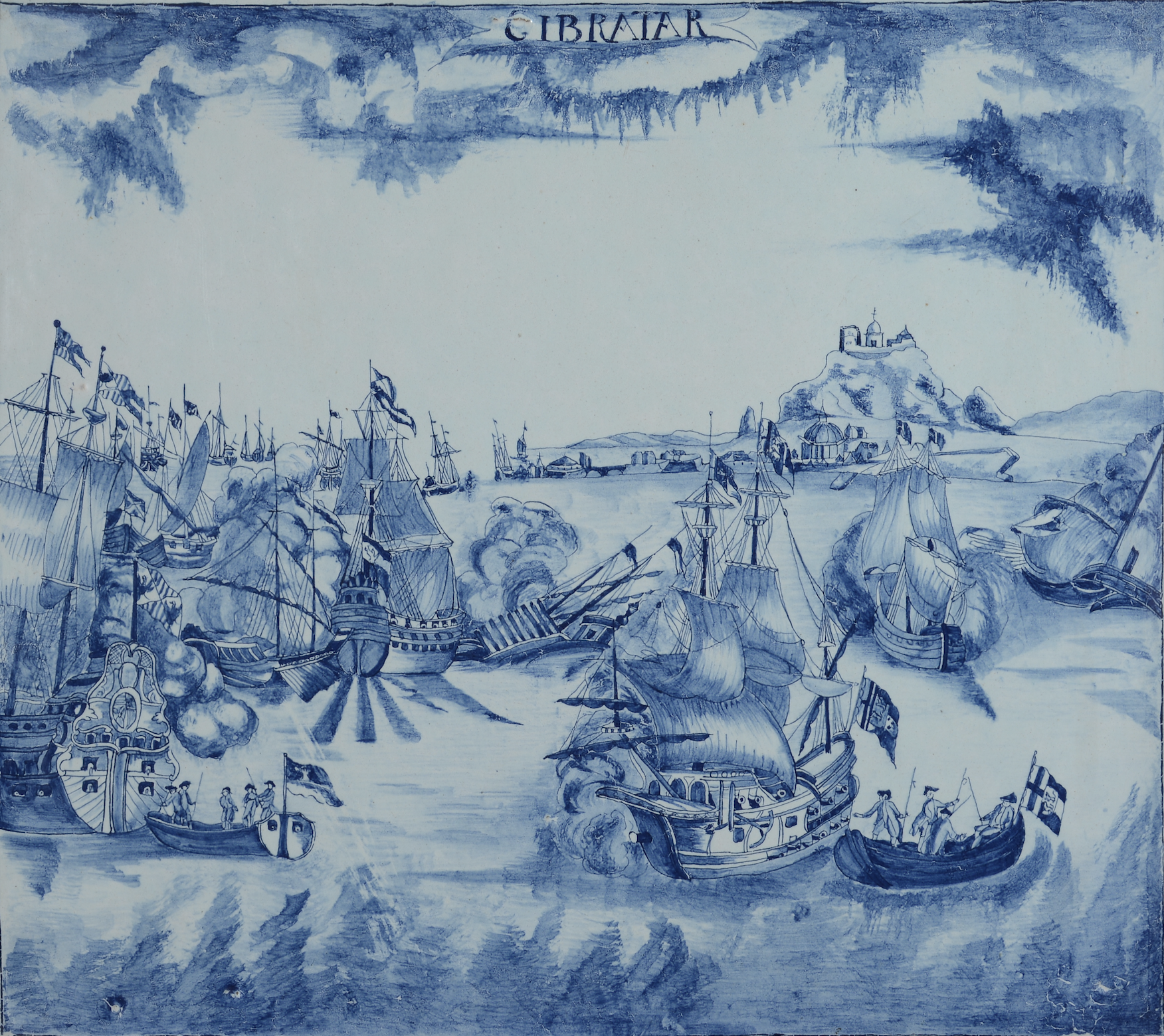
Gibraltar

An impressive large Delft plaque in the Aronson collection shows the Twelfth Siege of Gibraltar, an historic event between a Spanish-French fleet and combined Anglo-Dutch forces in 1704-1705 (Fig. 1). The scene is rather remarkable, because despite the triumph of the Anglo-Dutch fleet, the Dutch Republic suffered a humiliating end. This article explores the historical context of the Dutch connection with Gibraltar. Additionally, a fresh perspective is introduced regarding the scene and the inspirational source behind this intriguing plaque.
Strategic Harbor
Gibraltar is located near the southernmost point of Spain, at the gateway to the Mediterranean Sea. It has held profound strategic significance for ages, attracting the interest of diverse civilizations. Throughout ancient history, it passed through the hands of the Phoenicians, the Greek, the Egyptians and Romans. Throughout the Middle Ages, governance of the city oscillated between rulers from territories in present-day Spain and Islamic rulers. In 1501, the recently unified Spanish Crown acquired control of the territory of Gibraltar until the Twelfth Siege of Gibraltar, when it was conquered by the English with the help of the Dutch.
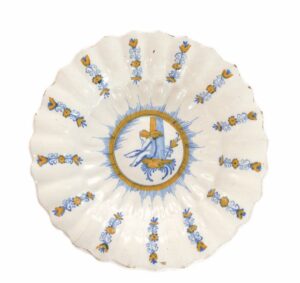
The Siege was not the first time that the Dutch entered the Strait of Gibraltar. In 1590, Dutch traders explored the Gibraltar strait as entrance towards the Mediterranean.(1) The undertaking was not without risks; the Dutch were embroiled in the ‘Eighty Years’ War’ (1568-1648) for their independence from Spain, while Gibraltar remained under Spanish control at the time. Driven by their commercial spirit, Dutch traders set sail to the Mediterranean region. It proved to be highly lucrative when in 1590 a famine struck Italy and its surrounding coastal areas. Grain sourced from the Baltic Sea region by Dutch traders, the focal point of trade discussed in our earlier article ‘Beyond Borders‘, was dispatched to Italy by sea, surpassing the traditional land routes in scale. The crucial waterway of the Strait of Gibraltar was consequently employed, and referred to as the ‘straetvaart’ by the people in the Dutch Republic. Interestingly, Dutch traders brought tin-glazed earthenware home from Italy, and called it ‘straetwerck’, named after the Straits of Gibraltar (Fig. 2).(2) The distinctive style and color palette on ‘straetwerck’, with blue, yellow, ochre, and occasional hues of manganese purple and green not only captivated the Dutch but also inspired emulation by local artisans. This category of imported ceramics played a significant role in the development of Dutch faience. Today, the surviving pieces of ‘straetwerck’ bear testimony to the enduring link between the Dutch Republic and Gibraltar.
In 1607, still engaged in the Eighty Years’ War, the Dutch embarked on a mission with a different purpose; to dismantle the Spanish fleet anchored in the Bay of Gibraltar, aiming to bolster their negotiating leverage. The Spanish were caught entirely off guard by the Dutch fleet of 26 small warships and four freighters, leading to the complete destruction of the Spanish fleet and its crew. This pivotal victory paved the way for peace talks in 1608 and the subsequent signing of the Twelve Years’ Truce the following year.
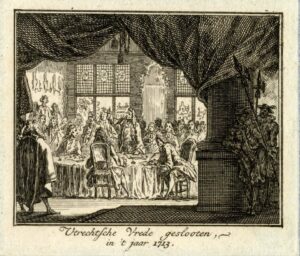
The scene that is depicted on the Delft plaque unfolds nearly a century later, when the ongoing political unrest in Europe led the Dutch to Gibraltar again. Upon the death of the feeble and ailing Spanish King Charles II in 1700, who left no heirs, he designated Philip of Anjou, a grandson of King Louis XIV, as his successor to the Spanish throne in his will. This decision placed Spain under the rule of a French king, although Charles explicitly stipulated that Spain and France should never be united as one kingdom. However, Louis had grand ambitions. He aimed to consolidate his power over the entire Spanish empire, including its colonies, through his grandson.
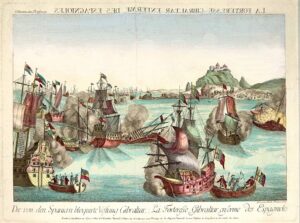
Louis’s aspirations threatened to make French dominance in Europe unstoppable. The issue of the Spanish succession quickly became a concern not only for Spain but for all of Europe. When Archduke Charles VI of Austria claimed the Spanish throne, he was supported by the Allied forces of England, the Dutch Republic, the Holy Roman Empire, Pro-Habsburg Spain and Savoy. Together, they declared war against Louis XIV in 1702 to halt French expansionism once and for all. While the initial battle unfolded in Northern Europe, the Allies redirected their focus towards undermining the maritime supremacy of the French and Spanish military- and trading fleets in the Mediterranean region following Portugal’s alliance with them in 1703. A combined Anglo – Dutch fleet was able to conquer Gibraltar in August 1704. Attempts to recapture the city failed, and subsequent efforts were ceased in May 1705 after 12,000 deaths and wounded in total on the Spanish-Franco side, against 1500 casualties out of 2442 soldiers on the Allied side. Gibraltar was the first Spanish city that fell into Allied hands, a blow for the Bourbon dynasty. The actual capture of Gibraltar meant a decisive point upon the way to the final peace treaty; the Treaty of Utrecht in 1713 (Fig. 3).
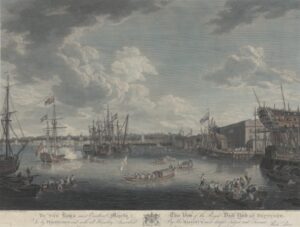
The Treaty of Utrecht, although of great importance for Europe, has been collectively neglected by the Dutch as National history for a long time. Betrayed by the secret negotiations between the English and the French in 1711, the Treaty signaled the end of the Golden Age and the prominent Dutch role as world power.(4) Furthermore, the Republic suffered the loss of the Southern Netherlands and had to concede the transfer of sovereignty over the Principality of Orange, which held historical significance as the birthplace of the Princes of Orange and later the Royal House of Orange, to French control. The series of events is something to be forgotten rather than celebrated from a Dutch perspective and therefore a questionable choice of subject for a Delft potter. This triggers further research.
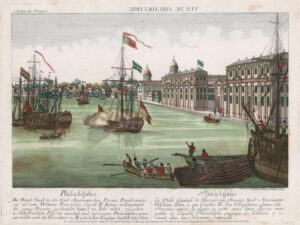
The scene captured on this remarkable plaque finds its origins in an optical print by a German artist Balthazar Frederick Leizelt, entitled ‘Die von den Spanieren Bloquirte Vestung Gibraltar’ from around 1780 (Fig.4). The captions appear in mirror writing due to the projection of these images in reverse with stereoscopes, which were popular among audiences across Europe at the time. Optical prints served to captivate tourists or to bring the world closer to curious viewers during a period of growing interest in exploration and discovery. They encompassed a wide array of subjects including architecture, landscapes, cityscapes, biblical scenes, and noteworthy events. However, optical prints were not renowned for their accuracy, often reflecting the creator’s imaginative interpretations. It was not uncommon for artists to replicate or draw inspiration from existing prints, sometimes altering the context entirely. An illustrative example is a print by William Woollett depicting the Royal Dock Yard in Deptford, England (Fig.5), which was replicated by Leizelt and reimagined as a view of Philadelphia on one side (Fig. 6) and New York on the other (Fig. 7).(5) According to the City Archive of Utrecht the print on Fig. 3 is also an imaginary scene, based on an earlier peace event in Utrecht in 1579.(6)
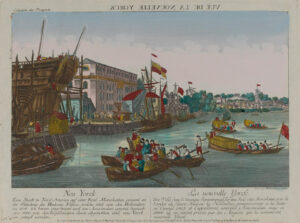
Leizelt’s optical print of Gibraltar could have similarly been altered. While Leizelt essentially mirrored an older engraving by his compatriot Johann Jakob Kleinschmidt (probably 1687-1772) (Fig. 8), the title of Leizelt’s work does not necessarily refer to the Twelfth Siege of Gibraltar in 1704-1705, as Kleinschmidt did, but more likely to the blockade of Gibraltar by the Spaniards, known as the ‘Great Siege’ commencing in 1779.(7) Although the Franco-Spanish forces tried to recapture Gibraltar by a siege in 1705, the Great Siege blockade could fit as a contemporary event at the time Leizelt released his print, which would also explain the gap in time between the two prints. It endured until 1783 and marked the longest siege in English history. The caption accompanying the print, ‘Se vend a Ausbourg au Negoce comun de l’Academie Imperiale d’Empire sous son Priviledge et avec defense ni d’en faire ni de vendre les Copies,’ and the bilingual title in German and French have been in use until at least 1779, aligning with the onset of this blockade.(8)
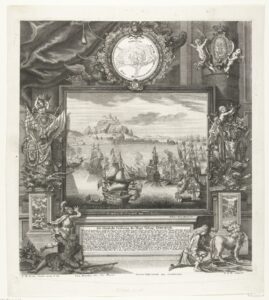
The depicted flags however, do not speak for this theory. A Sicilian flag adorns the ships at left on Leizelt’s print; although under Bourbon control in 1779, there is no evidence that Sicily participated in the ‘Great Siege’. The small vessel adorned with a striped flag bearing an eagle insignia might suggest an affiliation with the Spanish galley fleet. However, historical accuracy raises an eyebrow; the authentic Spanish flag of that era featured a tricolor of red, white, and yellow. Furthermore, a keen observer will detect a curious transformation in the scene’s narrative: the vessel nestled amidst two other ships in the background has undergone a subtle metamorphosis, shifting allegiances from Britain to Spain.(9) The inaccuracy of the flags may reflect the same unreliability of optical prints in general, thereby leaving the Great Siege theory described above still the most plausible.
Summarized, although the scene on the Delft plaque shows the Twelfth Siege of Gibraltar, after the original print by Johann Jakob Kleinschmidt; it likely intends to refer to the later Blockade of Gibraltar by the Spaniards known as the ‘Great Siege’, a newsworthy event by the time of the publication of the optical print by Leizelt. This Delft plaque therefore tells multiple histories, which makes it even more interesting.
Notes
1. Prof. Dr. P. Geyl, ‘De Geschiedenis van de Nederlandse Stam’, 1948-1959, p. 312
2. Ostkamp, S. Hollants Porceleyn en Straetwerck, in: Vormen uit Vuur 223/224, 2014, p. 20
3. Michael Clodfelter, ‘Warfare and Armed Conflicts: a Statistical Encyclopedia of Casualty and other Figures, 1492-2015, Jefferson, North Carolina, 2017, p. 73
4. Renger E. de Bruin, ‘Peace was made here: The tercentennial of the Treaty of Utrecht, 2013-2015′ in: Performances of Peace: Utrecht 1713, 2015, p. 267
5. ‘A View of America’, an exhibition at the John Carter Brown Library, Providence, Rhode Island, on the Occasion of the 41st Annual Meeting of the Associates. May 1984, pp. 3-4
6. https://hetutrechtsarchief.nl/beeldmateriaal/detail/4f863704-01f6-534d-b64b-adb87c4bf0a0/media/87c5ffb8-e235-16ec-0055-99abaf662853?mode=detail&view=horizontal&q=vrede%20van%20utrecht%201713&rows=1&page=46
7. This ultimate attempt of the Spaniards to re-conquer Gibraltar from the English failed again. Gibraltar proved it’s strategic value, as the English troops, almost a tenth of the Spanish-French 63,000 troops that gathered in 1782, held firm (https://exhibits.stanford.edu/ruderman/catalog/nj934cy8752)
8. C.J. Kaldenbach, De optica, een leerzaam kijkvermaak 2. Opticaprenten: uitgevers, graveurs en tekenaars in: De Boekenwereld. Jaargang 1, 1984-1985, p. 8
9. We extend our gratitude to Ms. Lesley Ross, General Secretary of the Flag Institute in Beverly, UK, for sharing her expertise in interpreting the flags featured in both prints.
Literature
Bruin, Renger E. de, ‘Peace was made here: The tercentennial of the Treaty of Utrecht, 2013-2015′ in: Performances of Peace: Utrecht 1713, 2015
Catalogue ‘A View of America’, an exhibition at the John Carter Brown Library, Providence, Rhode Island, on the Occasion of the 41st Annual Meeting of the Associates. May 1984
Clodfelter, Michael, ‘Warfare and Armed Conflicts: a Statistical Encyclopedia of Casualty and other Figures, 1492-2015, Jefferson, North Carolina, 2017
Kaldenbach, C.J.,’ De optica, een leerzaam kijkvermaak 2. Opticaprenten: uitgevers, graveurs en tekenaars’ in: De Boekenwereld. Jaargang 1, 1984-1985
Geyl, Prof. Dr. P., ‘De Geschiedenis van de Nederlandse Stam’, 1948-1959
Ostkamp, S. Hollants Porceleyn en Straetwerck, in: Vormen uit Vuur 223/224, 2014



